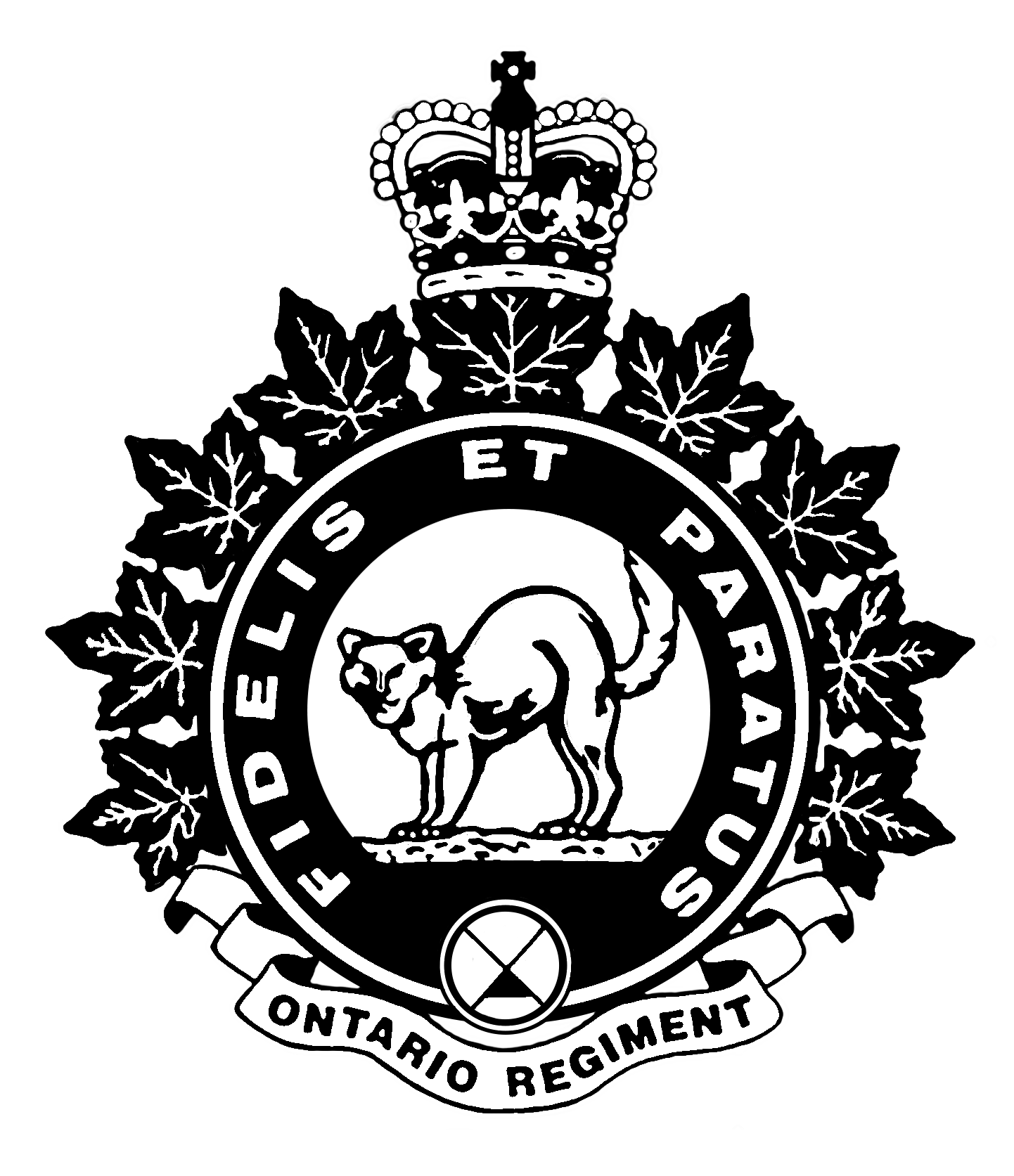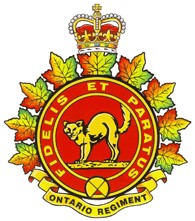In the last article covering the Ontario Regiment in the Second World War (“May 1940 – The Ontario Regiment Moves to Camp Borden”) the Ontarios had arrived at Camp Borden in late May, got settled into camp life and began training on the small fleet of Vickers Mark VIB light tanks at the Canadian Armoured Fighting Vehicles Training Centre (CAFVTC).
A hint at what the summer had in store for the Regiment came on 23 June with a warning order that the Ontarios would be required to furnish detachments to guard prisoners of war and other internees. The details came two days later and ordered the Regiment to send an advance party consisting of one officer, one Quarter Master Sergeant and nine other ranks to Quebec City to arrive on 27 June. Further, the Regiment was to provide an additional party of six officers and 133 other ranks to be ready to move as of the same day. A composite tank regiment, also at Camp Borden, was ordered to provide a similar number of soldiers.
The advance party was led by Captain Lyle Gerry and left by train on 26 June. On the 27th 300 Ross rifles arrived for the guard detachment. The main body departed on the 28th under the command of Captain Lyman Gifford, also traveling to Quebec City. The remainder of the Regiment carried on with the training as planned at Borden.
On 5 July it became clear that the Regiment’s plan for tank training would be completely disrupted. The Ontarios were ordered to provide a second guard detachment, this time consisting of 16 officers and 389 other ranks. Now the entire Regiment was part of the guard duty except for 76 recruits recently arrived from northern Ontario. These men were attached to the CAFVTC for the duration of the Regiment’s guard duty.

The first detachment spent the last days of June and the first two weeks of July practicing rifle drill, guarding prisoners as they came off the ships in Montreal, Trois Rivieres and Quebec City and traveling between those cities providing prisoner escorts. Late in the evening of 12 July these dispersed elements of the first detachment were reunited in Quebec City.
The second detachment arrived in Quebec City on 10 July and met up with the first detachment. The next two days were spent sorting out kit and training on the Ross rifle. Two ships carrying prisoners arrived at Quebec City and they were brought directly to their trains. Their destinations were the new prisoner of war camps in Espanola and Monteith, both in northern Ontario. Three trains arrived at the Espanola camp on the afternoon of 14 July and one train at the Monteith camp. All trains were guarded by the Ontarios.

Monteith, also known as Camp 23, was used largely for enemy alien internees, as opposed to prisoners of war. There were also merchant sailors among the 500 prisoners. The enemy alien internees were mostly German civilians who had the misfortune of being in the UK at the outbreak of the war. Many were anti-Nazi and had fled Germany before the war but the British government had all Germans interred. Fortunately for the Ontarios, the Monteith prisoners were quite cooperative.
Monteith was an ideal location for such a camp. It had originally been constructed as a prison farm but was sitting unused in the spring of 1940. Across the street from the front gate there was a train track which connected to the Canadian National Railway line not far away, making it easy to bring in prisoners and supplies. The site is now the location of the Monteith Correctional Complex.
The Espanola camp was located on the grounds of the idle Abitibi Paper Mill and was known as Camp 21. Its population of 1474 prisoners of war was mostly military – air crew, submariners and some soldiers. The Ontarios set up their Regimental Headquarters at Espanola. Today the site is owned by Domtar and is located here.
The terrain and climate of northern Ontario deterred escape attempts. Despite this, two Espanola prisoners made an attempt in the early morning hours of 18 July. A sentry observed two prisoners on the roof of a building at 02:00. He challenged them and then fired warning shots. The general alarm was sounded and the Regiment scrambled from their beds to respond. The two prisoners were apprehended and a count indicated they were the only two missing. The incident was not without its lighter side as John Richardson recalled many years later:
“I can still hear Jack Lowry (one of the corporals) trying to get me out of bed and threatening me with dire consequences if I didn’t respond. Well, he nagged me so much I finally succumbed. He was really mean. The amusing part of this episode was the squadron SQMS issuing five rounds of ammo per man for which we had to sign, when in the meantime, all hell was supposed to be breaking loose.”

There were morale problems among the soldiers at the Monteith camp. Captain Gifford butted heads with the camp commander, starting with the moment the train arrived at the camp. In a letter to Lieutenant Colonel Pearson, Captain Gifford outlined some of the issues they were having with the camp commander. Gifford stated that he had never met an officer, “that had such a vile tongue in his head and yet profess to be a gentleman.” The conflict led to many of the Ontarios being absent without leave. The situation was serious enough that Lieutenant Colonel Pearson left Espanola to visit the Monteith camp. The result of his investigation as to the reason for the absences was described in the war diary as “largely due to the eccentricities of the commandant” and “to a great extent by the friction between the commandant and Capt. Gifford.” Major J.H. Perry was sent to assume command of the Ontario Regiment detachment.
Other than the Espanola escape attempt, life was dull for the Ontarios at the two camps. Each day was similar to the next with routine guard duties and camp life. There were a few diversions from the boredom though. The prisoners at Monteith formed a choir and put on concerts. The Monteith detachment had the opportunity to visit the nearby town of Timmins which was described in the war diary as, “probably the highlight of the stay in Monteith”. There was a dance a few days later which the war diarist noted was “the most noteworthy day”, “eclipsing the trip to Timmins”. Both camps played sports. The Espanola detachment went swimming at Clear Lake.

The situation was looking more promising in late July at Monteith with the arrival of members of the Veterans’ Home Guard who began assuming duties as of 25 July. Another group of VHG soldiers arrived at Espanola in early August and mounted their first guard at that camp on the 6th. The guard duties were transitioned to the VHG over the course of a few days. Soon both camps were given their orders to prepare to return to Camp Borden.
The cordial nature of the Monteith prisoners was evident during the departure of the Ontarios on 14 August. A man named Friedlander was the leader of the prisoners. He made a speech, wishing the Regiment luck. The prisoners sang songs, cheered and waved shirts and handkerchiefs as the Ontarios’ train pulled away from the camp.
The Espanola detachment arrived back at Camp Borden at 06:00 on 11 August. They returned to the tent lines they had previously occupied and found partially completed huts waiting for them. There were walls and roofs but no floors, doors or windows. Half of the men left for a 48-hour leave and the other half had a similar leave when the first group returned. The Monteith detachment arrived at Borden on the morning of 15 August and also went on alternating leaves.
The Ontarios settled back in to life at Camp Borden and picked up their tank training. Colonel Frank Worthington, commander of the CAFVTC, visited the unit to explain that the training program would be accelerated, more equipment would be arriving and that the Canadian Armoured Corps was to be formed. Things were looking positive for the Ontario Regiment and all the mobilized tank regiments.
Rod Henderson
Rod Henderson is the Regimental Historian of the Ontario Regiment. He served as a Sergeant in the Regiment and is the author of “Fidelis Et Paratus: The History of The Ontario Regiment RCAC”.


